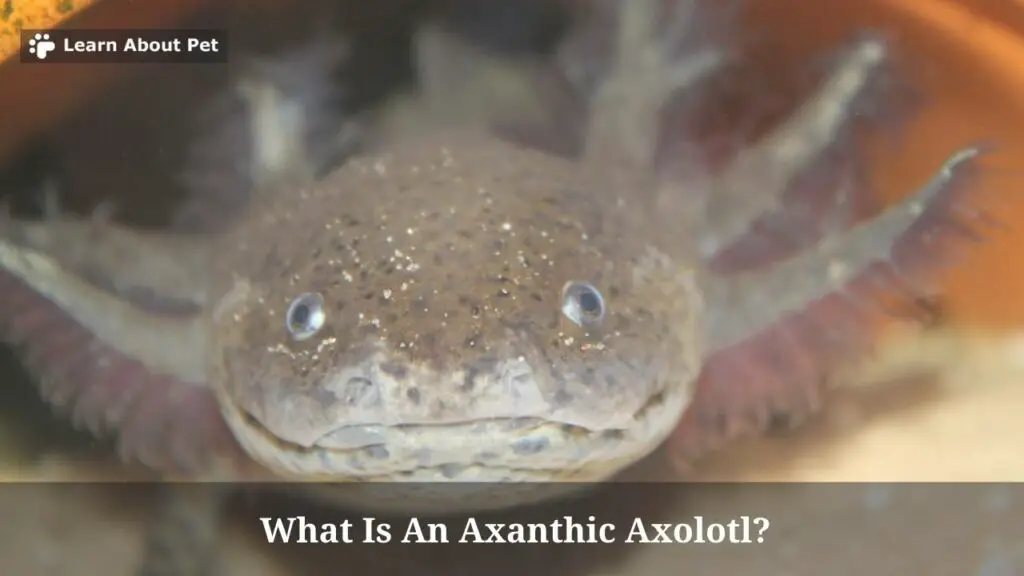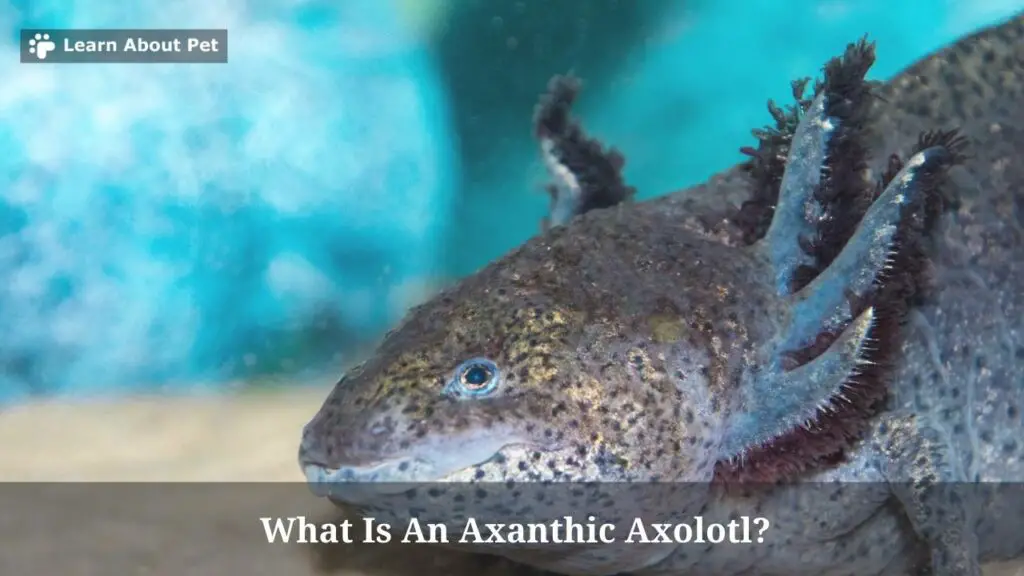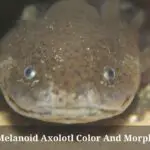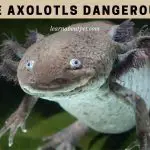Axolotl or Mexican walking fish has many morphs and colors. Because the Axolotl is starting to be classified as critically endangered, many enthusiasts want to take care of Axolotl to prevent it from becoming extinct. If you prefer to choose common Axolotl types, there are wild types and leucistic easily available.
If you want something more unique, you can choose the Axanthic Axolotl. Axanthic means they lack the yellow and red hues. Axanthic Axolotls are more likely to be grayish with a spotted look. This Axolotl has no xanthophores or yellow pigment.
The Axanthics can affect several morphs but is still considered its morph.
Not all Axolotl enthusiasts know about the Axolotl that lacks red and yellow color like Axanthic. Let’s read this article to the end.

What Is An Axanthic Axolotl?
Maybe we are familiar with some Axolotl morphs, such as white albino, melanoid, leucistic, wild-type, or piebald. But until now, we are not familiar with Axanthic.
What is Axanthic Axolotl? Axanthic is a morph that lacks xanthophores and iridophores or cells that produce yellow pigment and shiny looks in Axolotl’s skin. Although it doesn’t have the dominant red or yellow color, it gives them a cool spotted color and appearance.
Axanthic Axolotl Types And Colors
The Axanthic Axolotl has many types, such as Axanthic copper Axolotl, copper Axanthic, purple Axanthic, etc.
Before discussing some Axanthic types and colors, we need to know the facts about Axolotls in the table below
| Quick facts | Value |
| Lifespan | 10-15 years |
| Size | 6-18 inches |
| Minimum tank size | 10-gallon tank |
| Diet | Larvae, mollusks, worms, crustaceans |
| Temperature | 15 – 23 degrees C |
Every Axolotl has the right to live a healthy and always fulfilled life. Meet some vital things such as water temperature, water hardness, pH level, and other essential things. Don’t forget that Axolotls are solitary animals that prefer to be alone when in a tank. Since some facts about Axolotls have been discussed, it is time to discuss more Axanthic types and colors.
Copper Axanthic Axolotl
This Axanthic type has a highly sought-after lavender coloration all over the body, with a copper gills color. His eyes are black and have a spotted look all over his body. If you’re looking for a copper Axanthic Axolotl for sale, you’d expect it to be around $264-$299.
The Axanthic copper has started to be locally bred, but many enthusiasts are also targeting it because of the unique color of copper and the stunning color combination.
Purple Axanthic Axolotl
The lack of xanthophores and iridophores in the Axolotl Axanthic makes the color slightly darker but has an interesting variety.
One of them is the purple Axanthic with a purple hue all over the body. It makes some people fooled because it equates to melanoids.
To distinguish melanoid or Axanthic, you need to place the Axolotl under bluish light. The melanoids appear to have a blueish gray color, while the Axanthic have a purple hue.
There are some Axolotls whose purple color fades over time and some retain it through adulthood.
Axanthic Albino Axolotl
Some white albinos do not have a leucistic gene, but are Axanthic albinos. Because of this, many enthusiasts or scientists are confused about how to differentiate between Axanthic and albino with leucistic genes.
One trick to spot Axanthics albino is to do comparisons under uniform lightning. You can use a UV light to see Axanthics albinos by checking for face-fluorescence.
If you put Axanthic on white or light backgrounds, you can look straight through the Axolotl’s body. It is the hallmark of Axolotl enthusiasts to have an Axolotl that has a transparent body on a specific background.
Axanthic Leucistic Axolotl
The leucistic Axolotl is a common morph with a pink body and dark eyes. The special features of leucistic are bright pink gills with white bodies, but not albino.
There are still few references to Axanthic leucistic or Axanthic lucy, but one thing for sure is that Axolotl lacks yellow pigment in its skin.
The hallmark of Axanthic is the spotted body. If you find leucistic with many spots near the face or some parts of the body, then it is known as dirty lucy. We still don’t know whether a speckled leucistic is an Axanthic, but this morph lacks the yellow pigment and iridophores.
Axanthic Melanoid Axolotl
Let’s discuss one of the rarest Axolotls that you might find and is still an Axanthic, namely the melanoid Axanthic Axolotl. The beautiful solid lavender with gills blends purple and white.
It will be challenging to find this breed because it is rare and takes a long time to find.
One of the melanoid Axanthic copper Axolotls was once sold for $299-$334 because it was included as a rare morph. You will expect a price above $200 for an Axolotl, which has a unique color and is not easy to find anywhere.
Dark Axanthic Axolotl
Dark Axanthic is a combination of dark genes like wild-type Axolotls and Axanthics that lack iridophores and xanthophores. The color of this type is darker than purple or gray coloration and has spotted looks all over its body.
Dark Axanthic will not change color until adulthood, unlike some Axanthic, which fade over time.
If you put the dark Axanthic under a UV light, you will see their color is almost the same as blue light with a spotted body, and the color of the gills is slightly lighter than the rest of its body.
GFP Axanthic Axolotl
Although GFP or green fluorescent protein is more common in albino Axolotls, Axanthic can also have this gene.
The green GFP Axanthic Axolotl will emit a green glow from the protein in their body when you put the Axolotl under UV light.
There is one reference to someone who sells GFP Axanthic Axolotl with a very green eye color, spotted body, and slightly dark gills color.
The price offered is $125, not as expensive as copper Axanthic, only having a unique body that glows under the blue light.
High White Axanthic Axolotl
Another neat Axanthic is high white Axanthic. As the name implies, this type has high white markings and sometimes has long gills or is known as RLG. The body color remains dark but has a lot of white markings that make it a perfect color combination between purple hue and white.
One reference shows the price of high white Axanthic around $ 185 and belongs to the special Axolotl class. The high white spots make this Axolotl look like a leopard. The high white marks are not always from the head to the tail, but some have markings only on the belly.
Silver Dalmatian Axanthic Axolotl
What do you think about Dalmatians? Of course, your image is of a white dog with black spots all over its body. Axolotl also has this type, with white body color and dark spots. But is silver dalmatian Axolotl Axanthic?
Yes, including the Axolotl Axanthic with lavender, silvery purple hue, and dark spots all over his body. The Axolotl’s color looks silver because each Axanthic has a grayish or purple color. Some Axanthic will stay on that color until adulthood, and some change to green or gray as they age.

How To Care For Axanthic Axolotl Hatchling?
If you want to maintain multiple Axolotl hatchlings, you will need a dedicated tank smaller than a 10-gallon tank. Female Axolotls can lay many eggs in the tank up to hundreds of eggs.
Allow a few days for the hatchling Axolotl to develop.
Hatchling Axolotls still have to adapt to the aquarium and do not need special food. Leave it until they can move and become a lot more mobile.
Separate female Axolotls after laying their eggs because adult Axolotls can eat eggs or hatchlings.
How To Care For An Axanthic Axolotl Baby?
You still can’t see the type and color of Axanthic when you’re in the baby phase. If you want to target the Axanthic copper Axolotl, you have to wait until it is juvenile.
Try not to put too many baby Axolotls in one tank because even if they are babies, they’re prone to cannibalism.
You must do a front feed to maintain the health of each baby Axolotl. Provide live foods for baby Axolotls such as brine shrimp or other protein of sufficient size to fit in their mouths.
Baby Axolotls need a lot of food. Ensure you can provide two meals per day by looking at their diet.
Give food until they refuse it. Do not let a lot of food fall to the bottom because it can cause an ammonia spike.
A sign of Axolotl’s lack of food is aggressive towards their siblings. Axolotls can lose their gills or limbs because other babies are starving. Even though Axolotls can regenerate, you still have to ensure all Axolotls are full.
How To Care For Juvenile Axanthic Axolotl?
When they have entered the juvenile phase, you can reduce their feeding time to one meal a day. Their types and colors are starting to show. You can see Axolotl Axanthic gris, dark Axanthic, or other Axanthic types depending on the parent’s genetics.
Starting as a juvenile, you must transfer the Axolotl to a 10-gallon tank for each Axolotl. Juvenile Axolotls have nipping behavior that can interfere with one another.
If you allow the Axolotl to act aggressively, then one of the Axolotls becomes easily stressed and prone to disease.
Provide an attractive environment for Axolotls such as hiding places, aquarium plants, or water bubbles. Axolotls love to swim around even if they are alone in a tank.
The existence of hiding places and plants will provide comfort for them.
Where Can I Get Axanthic Axolotl For Sale?
The Axanthic Axolotls might be difficult to find because they are not common morphs like wild-type or leucistic. You can expect the price of white Axanthic Axolotls to start at $50 and up, slightly more expensive than the common morphs. The more unique the color, the more expensive the Axolotl will be.
For example, you’ll find copper Axanthic costs over $200. This price is common for rare Axolotl morphs. Try looking at aquatic pet stores or Axolotl enthusiasts.
Where Can I Get Axanthic Female Axolotl For Sale?
The female Axolotl is often sought after for all morphs because it can provide breeders with opportunities to get mixed breeds. The Axanthic Axolotl can give a unique variation because of its grayish or purple hue color, so color combinations such as lavender or silver can appear a lot.
Try to find Axanthic Axolotls on forums, hobbyists, or enthusiasts who can tell the difference between Axanthic and leucistic. If you still have little experience on how to differentiate between the two types, then you could be getting the Axanthic gene wrong.
Final Verdict – Axanthic Axolotl
Each Axolotl has its own unique morph and color. Axanthic is a type of Axolotl that lacks iridophores or shiny looks and xanthophores or lacks yellow pigments in the skin.
The color of the Axanthic can be grayish or purple hue with the characteristic that most of them have spots all over their body.

To differentiate between Axanthic and non-Axanthic, you need to place the Axolotl under a light background. The Axanthic colors will appear transparent, or you can see through their body.
This type of Axolotl is treated the same as other morphs, but only the unique color difference makes it Axanthic, one of the most popular Axolotls.
As a pet lover, make sure to learn about pet more and give your pet axolotl a good and comfortable life!

Welcome to Learn About Pet. My name is Rajkumar Ravichandran and I love all pets, travel, and amazing food. I write about my passion and personal experience caring for multiple pets in this blog! ❤️
Post Disclaimer
DISCLAIMER: THIS BLOG OR WEBSITE, "Learn About Pet", DOES NOT PROVIDE YOU WITH MEDICAL ADVICE AND IS NOT A SUBSTITUTE FOR MEDICAL ADVICE. ALWAYS GET IN TOUCH WITH YOUR PERSONAL VETERINARIAN AND USE INFORMATION HERE AS GENERAL ADVICE.
The information, including but not limited to, text, graphics, images and other material contained on this website are for informational purposes only. No material on this site is intended to be a substitute for professional veterinary advice, food recommendation, diagnosis, or treatment. Always seek the advice of your veterinarian or other qualified health care provider with any questions you may have regarding a medical condition or for pet food related questions.







